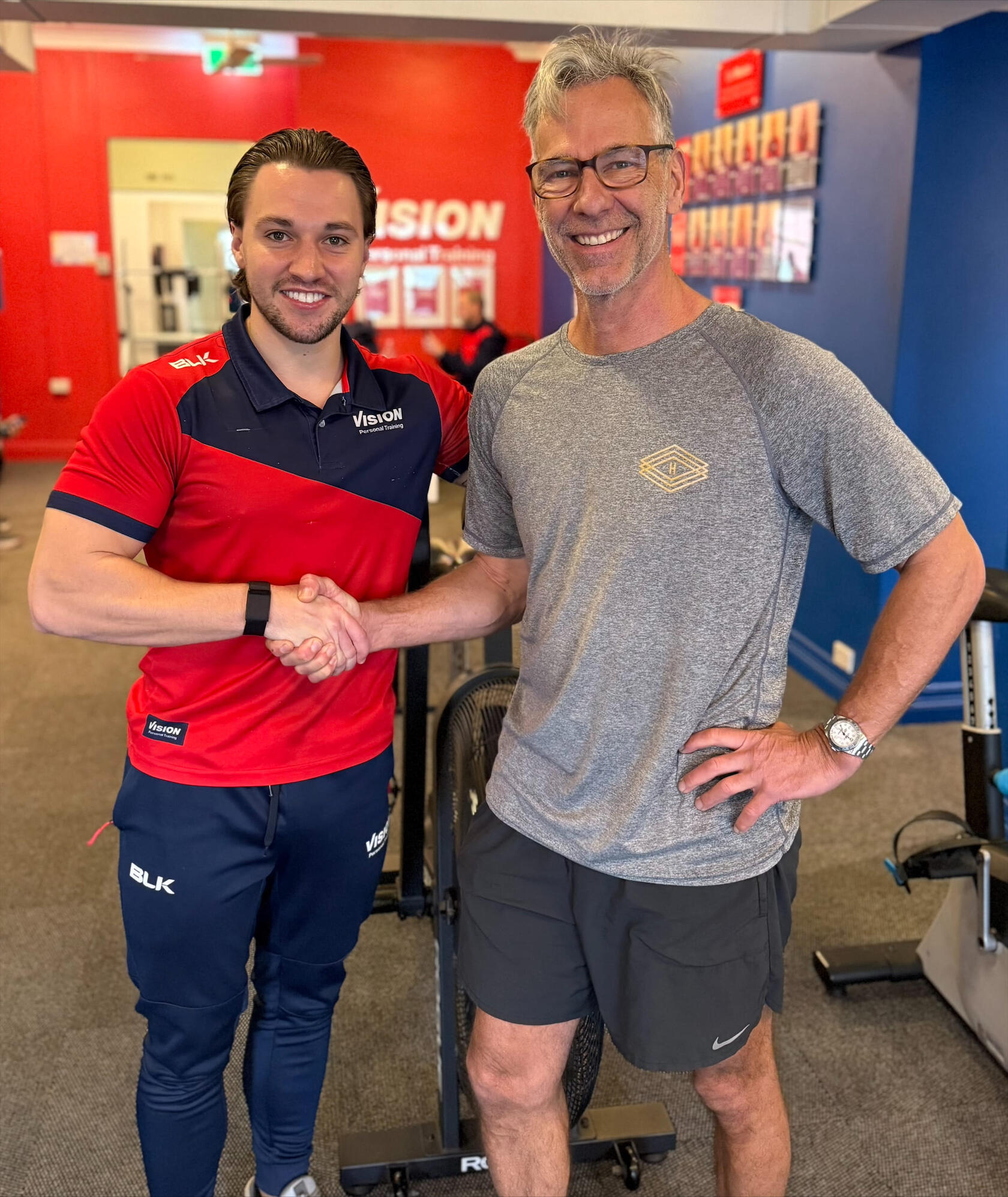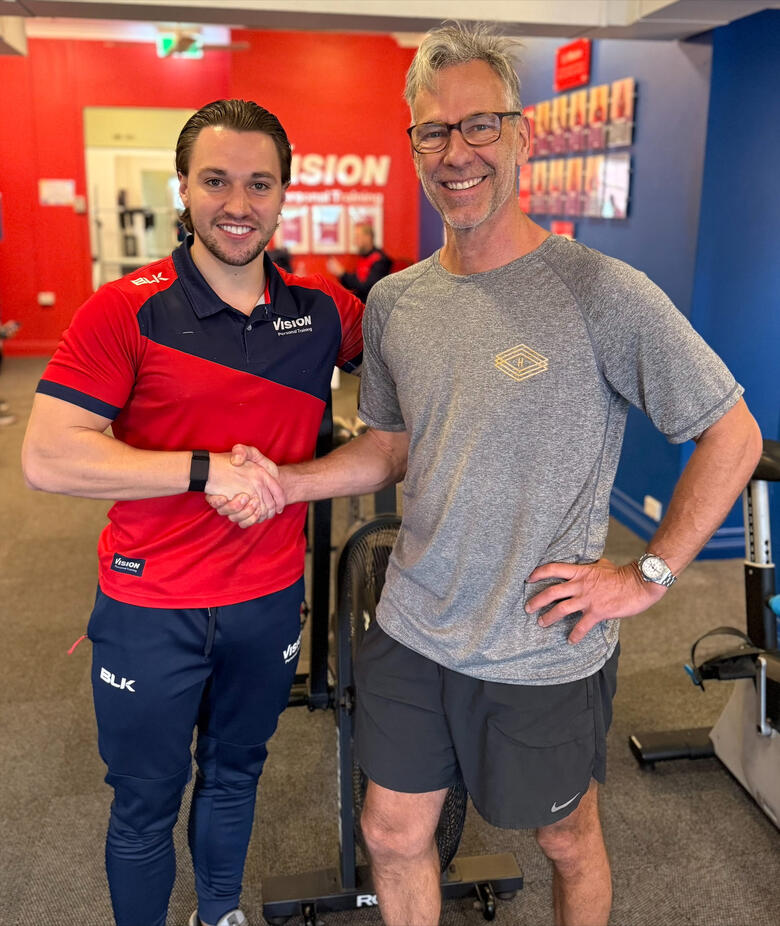Summary
Strength training isn’t just about getting fitter — it’s about building a stronger foundation for long-term health. For people managing or trying to prevent chronic conditions like type 2 diabetes, high blood pressure, arthritis or osteoporosis, resistance training is one of the most powerful and underused tools available. At Vision, we support clients who are prioritising their health, not just their physique. We see first-hand how the right plan, the right coach, and the right support can transform not only strength and mobility — but energy, mood, blood markers and confidence. This article explores the science behind how strength training improves key health outcomes, what the research says, how to get started safely (even if you’ve never touched a dumbbell), and why personalised coaching can make all the difference.
Key Topics Covered
- The Science Behind Strength & Chronic Disease Prevention
- How Resistance Training Improves Heart Health, Blood Sugar & Bone Density
- Starting from Scratch? Here’s What to Know
- Why Coaching and Community Matter More Than Ever
1. The Science Behind Strength & Chronic Disease Prevention
Why Muscle Matters as You Age
- As we move past our thirties, muscle responsiveness to exercise declines—but strength gains remain entirely possible. Professor Leigh Breen explains that with properly structured programs, people in midlife and beyond can still improve cardiovascular fitness, brain health, disease protection, and strength (The Guardian).
A Powerful Tool Against Chronic Disease
- Resistance training has been linked to a lower risk of diabetes, heart disease, and certain cancers. A review from Harvard Health highlights up to a 17% reduced risk of chronic disease and mortality by combining strength and aerobic training .
Metabolic Health and Blood Sugar Control
- In adults aged 50–70 with type 2 diabetes, strength training programs consistently show average reductions in HbA1c by ~0.4%, a clinically meaningful improvement (drc.bmj.com).
Cardiovascular Protection Beyond Cardio
- Progressive resistance training improves blood pressure, cholesterol, and body fat—all key factors in reducing cardiovascular risk (sciencedirect.com). Even when performed twice weekly, it significantly supports heart health.
Preserving Bone Health
- Lifting weights applies mechanical load to bones, stimulating density and reducing fracture risk. Resistance training is widely recommended for preventing osteoporosis (eatingwell.com, digitalcommons.murraystate.edu).
Mental Wellness and Cognitive Function
- Strength training reduces symptoms of depression and anxiety. A JAMA meta‑analysis confirmed a clear antidepressant effect, while cohort studies link resistance workouts to improved brain volume and functioning .
2. How Strength Training Supports Specific Conditions
Type 2 Diabetes
For those living with or at risk of type 2 diabetes, strength training is one of the most effective non-pharmacological tools available. It improves insulin sensitivity, lowers blood glucose levels, and builds lean muscle mass, which burns more energy even at rest.
A systematic review published in Diabetes Research and Clinical Practice found that resistance training led to meaningful reductions in HbA1c (a key marker of long-term blood sugar control), even without weight loss — and results improved further when paired with aerobic exercise (BMJ Open Diabetes Res Care, 2022).
At Vision, we tailor programs around your health profile, including blood sugar response, ensuring your sessions are safe, progressive, and monitored — especially if you're balancing medication, fatigue, or weight changes.
Heart Health
When most people think about improving their heart health, they default to cardio — but strength training deserves equal attention.
According to a 2024 review published in Revista Portuguesa de Cardiologia, resistance training helps reduce blood pressure, improves cholesterol balance, lowers body fat percentage, and strengthens the heart muscle itself when done consistently and at moderate intensity (ScienceDirect, 2024).
Importantly, even low-volume strength training twice per week has been shown to lower cardiovascular disease risk, especially in those aged 45 and up. That means you don’t need to spend hours in a gym — you just need the right approach and accountability. At Vision, we provide that in a safe, coaching-led environment that supports consistent improvement
Osteoporosis and Bone Health
Weight-bearing exercise is critical for protecting bone density — especially after 50 when bone loss naturally accelerates. Without the stimulus of load or impact, bones become weaker and more prone to fractures.
A study from Murray State University emphasised how strength training stimulates osteoblast activity (bone-forming cells) through mechanical stress. This makes it a first-line recommendation for preventing and managing osteoporosis — especially in combination with proper nutrition and hormonal health support (Murray State University Research, 2023).
We’ve seen many Vision clients in their 50s and 60s improve posture, balance, and overall confidence after just a few months of tailored strength sessions — helping them feel less fragile and more empowered in their daily lives.
Joint Pain and Arthritis
One of the most common misconceptions is that strength training is “too hard on the joints.” In reality, well-designed resistance training is one of the best ways to protect and support joint health.
According to the Arthritis Foundation, strength training strengthens the muscles around joints, improves flexibility, and reduces pain and stiffness in people with osteoarthritis. Far from worsening symptoms, it often enhances daily function (arthritis.org).
At Vision, our programs are modified to your starting point — whether that means using bodyweight, resistance bands, or controlled machine-based movement — and progress slowly over time. We avoid “one size fits all” and focus on sustainable outcomes.
Mental Health and Mood Disorders
Strength training doesn’t just shape your body — it can change your brain.
A large 2018 meta-analysis in JAMA Psychiatry concluded that resistance training significantly reduced symptoms of depression, even in participants without a formal diagnosis (JAMA Psychiatry, 2018).
These benefits appear to stem from:
- Increased endorphins and dopamine
- Improved sleep quality
- A sense of accomplishment and control
Regular social interaction (especially in supportive communities like Vision)
For people navigating stressful life transitions or mental health challenges, strength training becomes a powerful tool for stability and self-efficacy. Combined with our one-on-one coaching, the confidence boost from physical progress often becomes a catalyst for wider transformation.
3. A Beginner’s Guide: How to Start Safely and Confidently
Starting strength training can feel intimidating — especially if you’ve never stepped foot in a gym, are managing a chronic condition, or are worried about doing it “wrong.” But here’s the truth: you don’t need to be fit to begin. You just need the right support system.
At Vision Personal Training, we specialise in working with people in their 40s, 50s, 60s and beyond — people who’ve prioritised family, career, or recovery for years and are now ready to take back control of their health. Many of our clients come to us after a diagnosis (like type 2 diabetes, osteopenia, or high blood pressure) or simply feeling fatigued, stiff, and unsure where to begin.
This is exactly where our coaching-led model changes everything.
We Track What Matters — So You Can See What’s Working
When managing a chronic condition, results aren’t just about how you look — they’re about how you feel and what your health markers are telling you.
That’s why we use the MyVision App to keep you motivated and on track. It’s youraccountability partner — and it’s exclusive to Vision clients.
With the MyVision App, you can:
- Log your workouts and track progress in real time
- Monitor key health and fitness data like strength improvements, weight, and goals
- Access your food diary and nutrition plans
- Celebrate weekly wins and milestones that keep you moving forward
Whether you’re aiming to reduce medication, improve your energy levels, or simply move better in daily life, this kind of structured visibility makes a real difference.
Safe, Sustainable Progress — Designed for You
Every training session is carefully structured by your coach to ensure you’re improving without injury or overload. And if you’re new to exercise, we’ll focus on building strength and mobility using just your bodyweight or light resistance — gradually increasing intensity as your confidence grows.
This is where Vision is different:
We’re not focused on quick fixes or pushing you to extremes. We’re focused on long-term health transformation — built on real coaching, real connection, and real progress.
4. Why Community & Coaching Make All the Difference
At Vision, we’ve seen time and time again: when you feel supported, you stay consistent. And when you stay consistent, results follow — not just physically, but emotionally, mentally, and socially too.
You’re Not Meant to Do This Alone
One of the biggest challenges for people managing a chronic condition — or just trying to stay healthy long-term — is accountability. You might know what to do, but without the right environment, it’s easy to fall off track.
That’s where the power of coaching and community comes in.
- Your Vision Personal Trainer isn’t just there to run you through a workout. They’re your partner in change — checking in, adjusting your program when life gets busy, and keeping you focused on your long-term goals.
- Our studios are full of members just like you — people choosing health over hype, showing up for themselves week after week.
- And with tools like the MyVision App, we make sure you’re supported even when you’re not in the studio — from nutrition guidance to progress reviews.
Connection = Consistency
Research consistently shows that people are more likely to stick with a healthy lifestyle when they feel part of a supportive group. One study published in the British Journal of Health Psychology found that individuals were more likely to sustain exercise habits when they had strong social support and clear goals (Luszczynska et al., 2007).
It’s why we design Vision experiences with connection in mind. From small-group training and accountability check-ins to community challenges and shared milestones, everything we do is about helping you stay motivated — and never feeling like you're “starting over” again.
It’s Not About Keeping Up — It’s About Showing Up
At Vision, we don’t believe in one-size-fits-all workouts, rigid meal plans, or aggressive gym culture. We believe in meeting you where you are — then walking alongside you every step of the way.
Whether you’re:
- Getting back into movement after years off
- Managing a diagnosis like type 2 diabetes or high cholesterol
- Building strength and balance to protect your independence
- Or simply tired of the quick-fix cycle and ready to play the long game...
You’re in the right place.
Because when you combine personal coaching, real relationships, and proven systems — you unlock confidence that lasts far beyond the studio.

